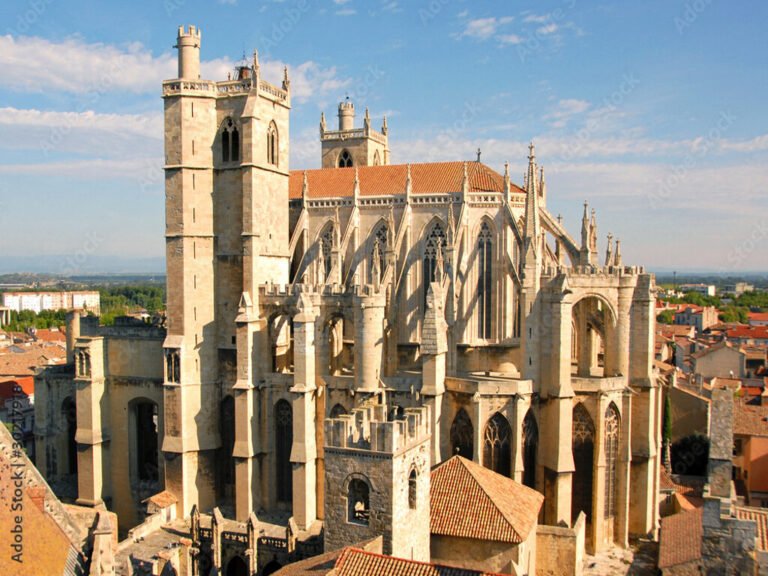The Cathedral of Narbonne: Saint-Just-et-Saint-Pasteur
Narbonne Saint-Just-Et-Saint-Pasteur Cathedral is the most prestigious monument in the city, located in the heart of the medieval historic center. This masterpiece of southern Gothic architecture testifies to the ambition and know-how of medieval builders. Although unacitched, it remains one of the most impressive and most visited monuments in the region.
Summary

History and construction
The construction of the cathedral began on April 13, 1272, when Archbishop Maurin laid the first stone. This ambitious project was decided in 1268 by Pope Clément IV, a former archbishop of Narbonne, in order to create a work comparable to the magnificent cathedrals of the Kingdom of France. The choir was completed in 1332, but the construction gradually stopped in the middle of the 14th century, leaving the building unfinished. Several finalization attempts took place over the following centuries, notably in 1514, 1708 and 1840, but none was completed.
Architecture and characteristics
The Saint-Just-Et-Saint-Pasteur cathedral is distinguished by:
- Its radiant Gothic style: directly inspired by large cathedrals in the north of France.
- Its unique choir: with an imposing dimensions 40 m wide, 60 m long, for a central vessel 15.20 m wide.
- Its vaults: rising 41 meters high, making it the fourth highest cathedral in France.
- Its buttons: on two floors and double-volley, of great finesse.
Remarkable elements
- The Notre-Dame de Bethlehem axial chapel: presenting a 14th century altarpiece in polychrome stone.
- The treasure room: also called a acoustic room, which houses a rich collection of liturgical objects, ivories, goldsmiths and tapestries.
- The cloister and the bell tower of the Church of Théodard: vestiges of a Carolingian pre -Roman cathedral built in 890.
Practical information
The cathedral is open every day of the year, with variable hours depending on the season. Entrance is free and guided tours are available on request for individuals and groups.
Why was Narbonne's cathedral never completely finished?
Narbonne Saint-Just-Saint-Pasteur Cathedral has never been completely completed for several complex and interconnected reasons:
- The opposition of the city consuls: the consuls categorically refused the destruction of part of the city's ramparts, necessary to continue the construction.
- The lack of resources: the high cost of the extraction and transport of stone in the South has contributed to stopping work.
- Difficult historical context: the Hundred Years War, the expedition of the Black Prince in 1355, and the black plague from 1348 to 1355, particularly virulent in Narbonne, disturbed the construction.
A long legal conflict opposed the chapter of the cathedral to the consuls of the city, starting in 1345 and extending for 8 years. A compromise was finally found in 1361, allowing the construction of the cloister leaning against the fortifications, but at the cost of the incompleteness of the cathedral.
How was Narbonne cathedral used politically in the 13th century?
Narbonne Saint-Just-Saint-Pasteur Cathedral was used as a powerful political instrument in the 13th century, reflecting power issues of the time:
- A symbol of Catholic authority: the construction of the cathedral, decided in 1268 by Pope Clément IV, aimed to assert the control of the Catholic Church in a recently reconquered region on Cathar heresy.
- An affirmation of the French royal power: the cathedral also symbolized Narbonne's submission to the kingdom of France, and its Gothic style, inspired by cathedrals of the North like Amiens, Metz or Beauvais, was a visual reminder of French influence in the region.
- A tool for political legitimacy: the iconographic program of the axial chapel, carried out around 1312, staged the Archbishop Gilles Aycelin de Montaigu alongside the King of France Philippe IV, highlighting the alliance between the local ecclesiastical power and the French monarchy.
- An ambitious project in the face of local tensions: the construction of the cathedral collided with the opposition of the consuls of the city, creating a legal conflict which lasted eight years (1345-1354), reflecting the tensions between the ecclesiastical power and the municipal authorities for the control of urban space.
In Cathedral Saint-Just-Et-Saint-Pasteur de Narbonne is a masterpiece of southern Gothic architecture, testifying to the ambition and know-how of medieval builders. Although unacitched, it remains one of the most impressive and most visited monuments in the region. Whether you are passionate about history, architecture or simply curious, a visit to this cathedral is an unforgettable experience.
Discover La Maison Gustave
Discover La Villa Ambrosia
Retain
- Radiant Gothic style: directly inspired by large cathedrals in the north of France.
- Impressive choir: 40 m wide, 60 m long, with a central vessel 15.20 m wide.
- High vaults: 41 meters in height, making it the fourth highest cathedral in France.
- Fine butters-buttors: on two floors and double-volley.
- Axial chapel: 14th century altarpiece in polychrome stone.
- Treasure room: collection of liturgical objects, ivories, goldsmiths and tapestries.
- Cloister and bell tower: vestiges of a Carolingian pre -Romane Cathedral built in 890.
Faq
What are the architectural particularities of the Saint-Just-Et-Saint-Pasteur cathedral?
Narbonne Saint-Just-Saint-Pasteur Cathedral has several remarkable architectural particularities:
- Style and dimensions: built in the radiant Gothic style, it has imposing dimensions for its choir.
- Vaults: rising at 41 m in height, making it the fourth highest cathedral in France.
- Bouting arcs: on two floors and double-volley, of great finesse.
- Choir: has 4 straight spans with an elevation at 3 levels.
- Triforium: with blind background wall and trèflated arcs, tablet between large arcades and canopies.
- Construction device: of great beauty, with seats adjusted in height.
- Vaults: remarkable perfection, testifying to a solid balance of the articulated masses.
Why was Narbonne's cathedral never completely finished?
Narbonne Cathedral has never been completely finished due to several factors:
- The opposition of the city consuls: main reason, they refused the destruction of part of the ramparts.
- The lack of resources: the high cost of the extraction and transport of stone.
- Difficult historical context: the Hundred Years War, the expedition of the Black Prince in 1355, and the black plague from 1348 to 1355.
- Legal conflict: between the chapter of the cathedral and the consuls of the city, starting in 1345 and extending for 8 years.
How was Narbonne cathedral used politically in the 13th century?
Narbonne Cathedral was used as a powerful political instrument in the 13th century:
- Symbol of Catholic Authority: to assert the control of the Catholic Church in a recently reconquered region on Cathar heresy.
- Affirmation of the French royal power: symbolized Narbonne's submission to the kingdom of France.
- Political legitimacy tool: the iconographic program of the axial chapel staged the archbishop alongside the King of France.
- Ambitious project in the face of local tensions: construction has come up against the opposition of the city's consuls, reflecting tensions between ecclesiastical power and municipal authorities.


